NEW YORK (Reuters Health) – Clinicians report in The American Journal of Surgery that a high white blood cell count or low serum sodium level can help diagnose necrotizing soft tissue infection (NSTI) in suspected cases where classic physical signs are absent.
In an earlier retrospective study, the Dr. Christian de Virgilio from Los Angeles Biomedical Institute at Harbor-UCLA Medical Center and colleagues showed that an admission white blood cell count greater than 15,400/µL and/or serum sodium level below 135 mEq/L could help differentiate NSTI from non-NSTI.
In the current study, the researchers confirmed this earlier finding in 21 consecutive patients with NSTI who were prospectively studied over a 17-month period. Dr. de Virgilio told Reuters Health: “Just based on the classic physical exam findings, necrotizing soft tissue infection was initially only suspected in 9 of the 21 patients and the reason is the physical exam findings were not very dramatic.”
Blood tests showed all 21 patients had either high WBC or low serum sodium, and the surgeon’s suspicion of NSTI significantly increased after being informed of the patients’ WBC and serum sodium values. In this series of NSTI patients, the mean admission WBC count was 31,500 µL and the mean serum sodium level was 127 mEq/L. Suspicion of NSTI increased from 9 patients to 18 patients after considering these laboratory criteria.
Dr. de Virgilio noted: “These abnormal lab values are more useful in their negative predictive value than their positive predictive value. If the sodium isn’t low and the white count isn’t above these criteria then you can be fairly comfortable that it is not this infection.”
Reference
Am J Surg 2008;196:926-930.




